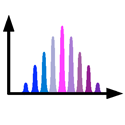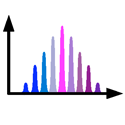Taking laser combs to higher frequencies
Frequency comb lasers produce light at many well-defined, finely spaced frequencies and thus act like hundreds of thousands of single-mode lasers all at once. Each of these frequencies can be calibrated with up to fifteen digits accuracy by comparison with primary frequency standards. Techniques designed to convert low frequency combs to higher frequencies where fewer light sources exist can lead to better atomic clocks and push the limits of precision atomic and molecular spectroscopy.
Dominik Kandula, Christoph Gohle, Tjeerd Pinkert, Wim Ubachs, and Kjeld Eikema at the Vrije Universiteit in Amsterdam, the Netherlands, announce, in Physical Review Letters, the generation of a frequency comb laser in the extreme ultraviolet part of the spectrum, reaching wavelengths near . Starting with an infrared frequency comb laser, they amplify two pulses, which they convert to the extreme ultraviolet (XUV) using high-harmonic generation in krypton gas. Furthermore, the team uses the light source to excite a beam of ground-state helium atoms and measure the transition frequency with an unprecedented accuracy. They find a ground-state ionization energy that is in agreement with recent theoretical predictions.
The results may be extendible beyond the XUV range to soft x-ray combs and allow for further tests of the theory of quantum electrodynamics with highly ionized atoms. – Sonja Grondalski





